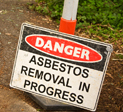
A simple blood test can reveal whether someone carries the genetic mutation for breast, colon and, possibly, even lung cancer. Years of research have allowed scientists to identify the mutations responsible for certain types of tumor development.
Scientists recently discovered the genetic mutation behind mesothelioma, an aggressive cancer of the lining of the chest and abdomen. About 3000 people die from it every year, nearly half within a year of being diagnosed. Asbestos causes most mesothelioma cases. Between 1940 and 1978, about 11 million people were exposed to the fibrous mineral, but symptoms typically don't show up for two to five decades, so the number of cases won't peak until about 2020.
The new study focused on two American families with a high incidence of mesothelioma and other cancers. Every family member who developed mesothelioma or melanoma of the eye had mutations in a gene called BAP1. In another 26 mesothelioma patients with no family history of cancer, a quarter of them also had BAP1 mutations. Some of these same patients developed other cancers such as breast, ovarian, pancreatic or renal cancers, suggesting BAP1 mutations contribute to other cancers.
Since the gene is responsible for repairing DNA damage and suppressing tumor activity, a mutation of BAP1 would predispose someone to cancer. While some genetic mutations are inherited, the vast majority are random. But for cancer to actually develop, there needs to be an accumulation of mutations in different genes which cause cells to grow out of control and spread.
As more tests become available, the ability to test for genetic mutations allows someone to avoid risky behavior. They could stay away from carcinogens such as asbestos, erionite ' another fibrous mineral, UV light, cigarette smoke and other mechanisms that may damage DNA.
More Information
As with other examples of disease information, those interested in more information about mesothelioma, asbestos and erionite should be cautious of the sources of that information, we advise that readers be especially vigilant about the entities that sponsor the web sites on these topics. Make sure that they are provided by reputable medical or scientific sources.
A report in ScienceDaily describes the discovery of mutations that make people more susceptible to two forms of cancer, mesothelioma and melanoma.
The Agency for Toxic Substances and Disease Registry has an excellent information page about the health effects of asbestos including lung cancer and mesothelioma.
For information about the mineral erionite which, like asbestos, has been linked with increasing the risk for mesothelioma, please read this article from ScienceDaily.
The emergence of erionite as a health hazard has been noted and reported on by the Centers for Disease Control in Atlanta. Their web page on erionite includes a map of the areas where it occurs in sedmentary rocks in the Western U.S.
The Atlas of Genetics and Cytogenetics in Oncology and Haematology is an online science journal and database devoted to genes, cytogenetics and clinical entities in cancer. It is an information portal and has important information about the BAP1 gene and the protein that it encodes as well as its known functions here.
The National Center for Biotechnology Information also provides an important database on biomedical and genomic information as well as links to a myriad of tools to analyze many kinds of data. The summary of the BAP1 gene can be read here.